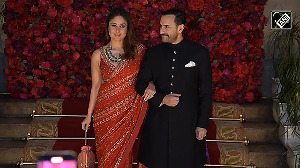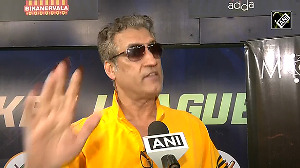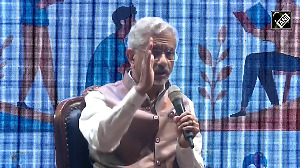Marathwada is the region comprising the eight districts of (divisional headquarters) Jalna, Aurangabad, Parbhani, Hingoli, Nanded, Latur, Osmanabad and Beed. Was once part of the erstwhile kingdom of the Nizam of Hyderabad.
It accounts for 16.84% of the state's population and is home to nearly 30% of the state's Below Poverty Line families.
Its per capita GDP is Rs 10,373 -- a good 40 per cent below the state's per capita GDP of Rs 17,029 -- and contributes just 8% of the state's industrial output.
Its literacy rate is the lowest in the state (51.23%, Census 2001). All eight districts figure in the list of the 100 poorest districts in the country. (Source: https://www.empowerpoor.org/backgrounder.asp?report=19)
Perhaps, the most neglected region of Maharashtra.
Why?
Lacks natural resources and is prone to drought. Nearly 32% of its 64,818 sq km area comes under the rain shadow region. Annual average rainfall is 750mm and drought is a permanent feature. Irrigation water, in real terms reaches not more than 50,000 acres of cultivable land. Getting supply of drinking water twice a week is a luxury. This year, the picture has been slightly better owing to a good monsoon.
About 98% of agriculture is dry land farming and cotton is the major crop. But the inherent susceptibility of cotton crop to pest and the vagaries of nature make its cultivation a risky affair, resulting in many a farmer falling prey to debt. Suicide among farmers is on the rise.
![]()
Facts at a Glance
![]()
![]()
![]()
![]()
Location: Roughly 400km southeast of Mumbai
Major city: Aurangabad
Approximate area: 64,818 sq km
Languages: Marathi, Urdu (Hyderabadi accent) and Hindi
Literacy: 51.23% (Census 2001)
Per capita GDP: Rs 10,373![]()
![]()
Industry?
The most famous is the Bajaj Auto Plant at Waluj, near Aurangabad. Others are the factories of Videocon (television), Garware Polyester, Colgate (toothpaste), Crompton Greeves, Wockhart.
Neighbouring Jalna district has a few industries but otherwise people are dependent on agriculture for employment.
So, what do the people do?
Cotton farming for about seven months in a year. Otherwise nothing. Thus, projects under the state-run employment guarantee scheme (EGS) overflow with unemployed educated youth as well as school going children for nearly five months of the year when farm work comes to a grinding halt.
Last year, a record 500,000 persons reported at EGS centres. It is common to see post-graduates and students from vocational training colleges toiling on road construction sites.
Many shift to western Maharashtra each year to work as sugarcane cutters. Army recruitment drives always get a good response.
What is this region famous for?
The world heritage sites of Ajanta and Ellora caves near Aurangabad.
Other tourist attractions are the meteorite crater at Lonar, Aurangzeb's tomb at Khultabad, Guru Gobind Singhji Gurudwara at Nanded, which is the second most sacred pilgrimage centre for Sikhs after the Golden Temple at Amritsar, two of the 12 Jyotirlingas --- at Grushneshwar (Aurangabad district) and Parli-Vaijnath (Beed district).
Marathwada is referred to as the land of saints. Sant Tukaram, Samarth Ramdas, Sant Dyaneshwar all hailed from this region.
What are the issues in this election?
Jobs. Also, so little has been done for Marathwada that development is always an issue. Voters want representatives who can get the state govt to pump funds into the region.
However, people tend to vote along caste lines relegating important issues to the background.
What is the composition of the people?
There is a sizeable dalit population (SC 14.96%, ST 4.01%).
Nearly 25 per cent of population comprises Muslims. Communal tensions flare up every now and then. In fact, it was this communal divide that helped the Shiv Sena find a foothold in 1988. Until then, the MLA representing Aurangabad was always a Muslim, one of them being the illustrations Islamic scholar and statesman, Dr Rafiq Zakaria.
Voting trend?
The region is divided into 46 assembly and eight parliament constituencies.
The Congress held sway until the last assembly elections, when the Shiv Sena emerged as the single largest party bagging 17 seats while its ally, the BJP, garnered nine. The Congress got just 10 seats while the NCP six. Independents bagged the remaining four seats.
The Nationalist Congress Party has little say while the BJP limits its resources and energy to its strongholds.
People welcomed the Shiv Sena because it enjoys a reputation of putting its weight behind the common man and discouraging feudal culture. But party chief Bal Thackeray's inability to campaign in the region has put too much pressure on its candidates this time.
Also, the Bahujan Samaj Party is likely to affect the outcome by attracting dalit voters. Its leader Mayawati has put up candidates in each of the 46 constituencies.
Top political personalities?
Marathwada has contributed three chief ministers, all from the Congress -- S B Chavan (Nanded district), Shivajirao Patil Nilangekar (Latur district), Vilasrao Deshmukh (Latur district).
At the national level, S B Chavan and Shivraj Patil (Latur) have graced the Union home ministry. The latter has also served as the speaker of the Lok Sabha.
Pramod Mahajan (Beed district) is a leading member of the Bharatiya Janata Party who has served as Union defence minister. Mahajan's brother-in-law and BJP leader Gopinath Munde has been deputy chief minister of the state.
Who comprises the elite? How do they get there?
Politicians and sugar barons. Most politicians own either a petrol pump or a gas agency. Some operate educational institutes.
People line their pockets by diverting public funds. The biggest example in recent times is state minister Dr Padamsinh Patil who reportedly diverted lakhs of rupees collected by his sugar factory for the Kargil Relief Fund.






 © 2025
© 2025